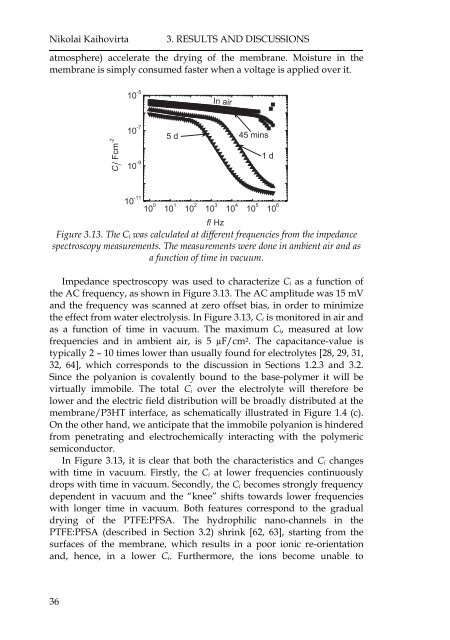ION MODULATED ORGANIC TRANSISTORS - Doria
ION MODULATED ORGANIC TRANSISTORS - Doria
ION MODULATED ORGANIC TRANSISTORS - Doria
- No tags were found...
Create successful ePaper yourself
Turn your PDF publications into a flip-book with our unique Google optimized e-Paper software.
Nikolai Kaihovirta3. RESULTS AND DISCUSS<strong>ION</strong>Satmosphere) accelerate the drying of the membrane. Moisture in themembrane is simply consumed faster when a voltage is applied over it.C i/Fcm -210 -510 -75d10 -945 mins1dIn air10 -1110 0 10 1 10 2 10 3 10 4 10 5 10 6f/ HzFigure 3.13. The C i was calculated at different frequencies from the impedancespectroscopy measurements. The measurements were done in ambient air and asa function of time in vacuum.Impedance spectroscopy was used to characterize C i as a function ofthe AC frequency, as shown in Figure 3.13. The AC amplitude was 15 mVand the frequency was scanned at zero offset bias, in order to minimizethe effect from water electrolysis. In Figure 3.13, C i is monitored in air andas a function of time in vacuum. The maximum C i , measured at lowfrequencies and in ambient air, is 5 µF/cm 2 . The capacitance-value istypically 2 – 10 times lower than usually found for electrolytes [28, 29, 31,32, 64], which corresponds to the discussion in Sections 1.2.3 and 3.2.Since the polyanion is covalently bound to the base-polymer it will bevirtually immobile. The total C i over the electrolyte will therefore belower and the electric field distribution will be broadly distributed at themembrane/P3HT interface, as schematically illustrated in Figure 1.4 (c).On the other hand, we anticipate that the immobile polyanion is hinderedfrom penetrating and electrochemically interacting with the polymericsemiconductor.In Figure 3.13, it is clear that both the characteristics and C i changeswith time in vacuum. Firstly, the C i at lower frequencies continuouslydrops with time in vacuum. Secondly, the C i becomes strongly frequencydependent in vacuum and the “knee” shifts towards lower frequencieswith longer time in vacuum. Both features correspond to the gradualdrying of the PTFE:PFSA. The hydrophilic nano-channels in thePTFE:PFSA (described in Section 3.2) shrink [62, 63], starting from thesurfaces of the membrane, which results in a poor ionic re-orientationand, hence, in a lower C i. Furthermore, the ions become unable to36
















